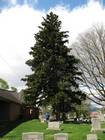
Illustration by Siebold and Zuccarini (1835).

Mature tree in cultivation, North Carolina, USA [Will Blozan, 2009.04.12].

Bark of the above tree [Will Blozan, 2009.04.12].

Cone of the above tree [Will Blozan, 2009.04.12].

Cone-bearing branch on the above tree [Will Blozan, 2009.04.12].

Cone variation on the above tree [Will Blozan, 2009.04.12].

Picea torano
(Siebold ex K.Koch) Koehne 1893
Common names
ハリモミ, hari-momi, bara-momi torano-momi [Japanese] (Iwatsuki et al. 1995), tiger-tail spruce [English], Tigerschwanz-Fichte [German].
Taxonomic notes
Synonymy:
- Abies torano Siebold ex K.Koch 1873;
- Pinus torano (Siebold ex K.Koch) Voss 1907;
- Abies polita Siebold et Zucc. 1842 nom. illeg.;
- Pinus polita (Siebold et Zucc.) Antoine 1846;
- Picea polita (Siebold et Zucc.) Carrière 1855.
The name Picea polita is more often seen than Picea torano, being the norm, at least until the early 21st Century, in most published floras and most horticultural texts.
Description
Monoecious, evergreen tree to 30 m tall and 100 cm dbh. Bark grey-brown, deeply fissured and peeling off in scales. Branchlets stout, brown, glabrous, deeply grooved; pulvini stout, 0.6-0.7 mm long. Leaves stiff, hard, sharp-pointed (some consider them the sharpest among all the spruces), linear, quadrangular, ridged, 15-20 mm long, ca. 2.5 mm across, deep green, with a stomatal band on each side; resin canals two, marginal. Flowers May to June, 1-3 near apex of previous year's short shoots. Pollen cones cylindric, red-purple, with numerous microsporophylls. Seed cones pendant, ovate-oblong, green maturing (in October) brown, 7-10 cm long, 4-4.5 cm across. Cone scales persistent, widely obovate, thinly woody, 17-23 mm long, 14-18 mm wide, irregularly denticulate on upper margin; bract scales very small, inconspicuous. Seeds black-brown, obovate, ca. 6 mm long, 3 mm wide; wings brown, obovate ca. 13 mm long, 7 mm wide (Iwatsuki et al. 1995). See García Esteban et al. (2004) for a detailed characterization of the wood anatomy.
Distribution and Ecology
Japan: Pacific Ocean side of C Honshu (westward from Fukushima Prefecture), Shikoku and Kyushu, in the mountains at elevations of (400-)600-1700(-1850) m on volcanic soils (Farjon 1990, Iwatsuki et al. 1995). Hardy to Zone 6 (cold hardiness limit between -23.2°C and -17.8°C) (Bannister and Neuner 2001).
The climate is moist-maritime, with annual precipitation of over 1,000 mm and cold, snowy winters. Occasionally forms pure stands but more often occurs in mixed stands with species such as Abies homolepis, Larix kaempferi, Pinus densiflora, Betula, Acer, Fagus, Quercus, Prunus, and Zelkova serrata (Farjon 1990).
Remarkable Specimens
Ethnobotany
Observations
Lake Yamanaka at the base of Fuji-San is often mentioned for its remarkable pure forest of Picea torano (Wilson 1916, Farjon 1990).
Remarks
The epithet is one of the Japanese common names for this tree.
Citations
Farjon, Aljos. 1990. Pinaceae: drawings and descriptions of the genera Abies, Cedrus, Pseudolarix, Keteleeria, Nothotsuga, Tsuga, Cathaya, Pseudotsuga, Larix and Picea. Königstein: Koeltz Scientific Books.
Koehne, B. A. E. 1893. Deutsche Dendrologie, p. 22. Available: Real Jardín Botánico Biblioteca Digital, accessed 2020.11.28.
See also
Elwes and Henry 1906-1913 at the Biodiversity Heritage Library (as P. polita). This series of volumes, privately printed, provides some of the most engaging descriptions of conifers ever published. Although they only treat species cultivated in the U.K. and Ireland, and the taxonomy is a bit dated, still these accounts are thorough, treating such topics as species description, range, varieties, exceptionally old or tall specimens, remarkable trees, and cultivation. Despite being over a century old, they are generally accurate, and are illustrated with some remarkable photographs and lithographs.
The species account at Threatened Conifers of the World.






